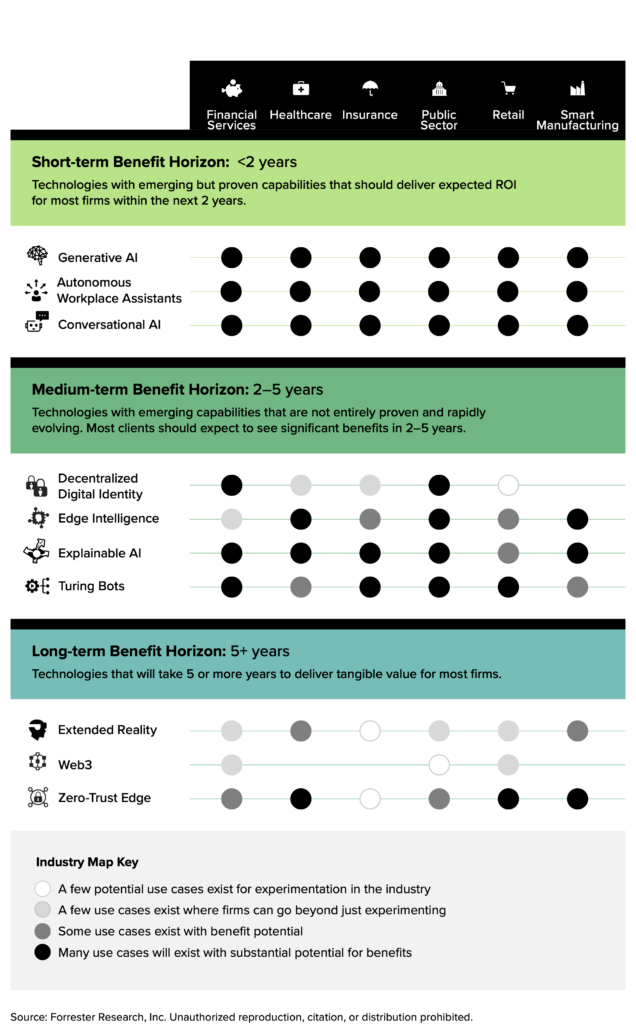Generative AI Dominates The Top 10 Emerging Technologies Of 2023
Two weeks ago, I blogged on our process for selecting Forrester’s top 10 emerging technologies for 2023. As part of that post, I introduced the Benefits Horizon model, which makes our call on when emerging technologies will deliver benefits for most firms. On Monday, we published our annual report, The Top 10 Emerging Technologies In 2023, and released a companion digital experience for clients. Both are organized by benefits horizon to help firms make their own calls, depending on how advanced they are.
You can read our press release that provide some details on each technology. Here is the main figure from our report that summarizes or list and provides an industry impact analysis:

Generative AI Dominates Our 2023 List
Generative AI’s dominance of this year’s list will come as a surprise to no one, given the astounding capabilities that everyone can observe in the many publicly available tools. We’re even using DALL·E to help create images for the top emerging technologies webinar that we are hosting on July 25. Be sure to sign up and see how generative AI translated some thoughts about emerging technology into imagery. Generative AI also topped our list because of the boost it provides to many other top emerging technologies: Automated workplace assistants (AWAs), conversational AI, and TuringBots are examples.
The huge potential benefits are balanced by risks. How do you trust the outputs? How will they be regulated? What are the IP complications? How much will it cost to train and maintain differentiating models?
We think that generative AI will strain most firms’ ability to take risks and make good bets on emerging technology. While tools such as ChatGPT tantalize firms and venture investors with the opportunity to rethink almost every engagement and process, many executives are also dealing with a speed of advancement that they have never seen before (read my 2020 blog on the importance of being future fit). A few future fit firms will make smart bets and reap big benefits, and other more advanced ones will make some good bets and see the benefits, as well. Most organizations, however, struggle with the pace of change and management of risk. They will muddle along and watch leaders run away. There are also bound to be some spectacular failures to watch. My advice: Don’t be one of them.
How Did This Year’s List Change?
You’ll recognize several technologies on our 2023 list that were also on our 2022 one: edge intelligence, explainable AI, TuringBots, Web3, Zero Trust Edge, and extended reality. Of these, the most substantial change was in TuringBots — software robots that assist developers in writing code. We’re seeing a dramatic acceleration due to large language models and vendor efforts such as CoPilot. As a result, we shifted TuringBots from 5-plus years out in 2022 to our midterm horizon of 2–5 years in 2023.
Cloud-native computing and privacy-preserving technology (PPT) aren’t on the list this year. The former is no longer emerging in the same sense as other technologies on our list. For 2023, we labeled 18 technologies in our database as “emerged,” and this list includes cloud-native computing, along with robotic process automation (RPA) and low-code platforms. These are table stakes to stay competitive.
We further thought that two terms were too general: PPT and natural language processing (NLP). PPTs are not just one technology; there are many. We are writing research on the PPT technology ecosystem, publishing in Q3, that will include several emerging technologies such as homomorphic encryption. We also broke out generative and conversational AI from the generic term NLP, which we removed from our 2023 list.
Intelligent agents evolved into autonomous workplace assistants. AWAs are software robots that assist employees and automate business processes by incorporating AI components into business process management and RPA platforms.
New to the list is decentralized digital identity. We believe that this is the most important advancement in identity and access management, and it will have a big impact on privacy protection as it rolls out over the next 2–5 years.
Wrapping Up
I’d like to give a big thank you to all the analysts who helped with this research piece. It was truly a team effort! Please read their blogs and watch for posts on the aforementioned technologies: Julie Ask, Max Ball, Martha Bennett, Andras Cser, Rowan Curran, Michele Goetz, J. P. Gownder, David Holmes, Andre Kindness, Craig Le Clair, Diego Lo Giudice, Michele Pelino, and Brandon Purcell.
Here are some potential actions to consider:
- Sign up for our Juluy 25 webinar (open to Forrester clients and nonclients), and keep your eyes peeled for our upcoming What It Means podcast episode.
- Forrester clients can follow me for updates, and Forrester Decisions seatholders can request a guidance session with me to go deeper on our catalog and gain insight into our top 75 priority emerging technologies.
- If you need help building a technology watchlist, Forrester Consulting can tap our database of over 400 technologies and compare them to your watchlist, identifying gaps and helping you communicate strategies. I’m also starting to give top emerging technology lunch-and-learn and webinar sessions for clients; contact your account management team if you are interested in these.
- I’ll be hosting an entire track on these emerging technologies and more at our 2023 Technology & Innovation North America Forum in Austin, Texas, September 10–12. Hope to see you there!
